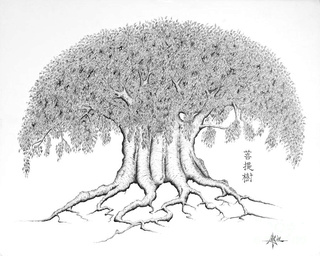Je trouver personnellement très instructif le fait que Sa Sainteté évoque l'harmonie possible entre le rangtong et le shèntong et l'harmonie entre le Madhyamaka et le Dzogchen lorsqu'il s'agit de la claire lumière objet (la vue ontologique de la vacuité):
The Harmony of the two correct views of reality
The text continues,
Nevertheless, when scrutinized by a yogi learned in scripture and logic and experienced [in meditation], their definitive meanings are all seen to come to the same intended point.
If we explain according to the Shangpa Kagyü tradition of Kaydrub Kyungpo, for instance, we can meditate on a correct view presented in terms of either devoid nature itself or something having this devoid nature, namely clear light mind. The latter is similar to Tsongkhapa's explanation in Precious Sprout, Deciding the Difficult Points of [Chandrakirti's] "An Illuminating Lamp [for 'The Guhyasamaja Root Tantra']". In the prologue section, commenting on a quotation from Nagarjuna's The Five Stages [of the Guhyasamaja Complete Stage], Tsongkhapa has mentioned that the inanimate environment and the animate beings within it are all the play or emanation of subtlest consciousness and subtlest energy-wind - in other words, simultaneously arising primordial clear light mind and the subtlest level of energy-wind upon which it rides. This is the same understanding as explained before concerning the correct view presented in terms of objects having a devoid nature.
As for the correct view presented in terms of devoid nature itself, Tsongkhapa has written in A Treasury of Commentaries on the Five Stages [of the Guhyasamaja Complete Stage] and A Lamp for clarifying the Five Stages [of the Guhyasamaja Complete Stage], "Many possess one taste and one taste is possessed by many." This refers to the fact that all objects emanated, in a cognitive sense, from primordial clear light mind have the same taste of voidness as their deepest nature. This explanation from tantra literature corresponds to the main madhyamaka assertion of the sutra presentation of the correct view presented in terms of devoid nature itself.
Although there are many traditions of explanation, the definitive meaning of voidness to which they all lead is exactly the same. Many erudite masters have explained voidness through logical lines of reasoning concerning the conventional and deepest levels of truth. But many other realized masters whose meditational experience did not accord exactly with these lines of reasoning have explained voidness by taking their innermost meditational experience as more significant than logic. If we examine the words of such masters strictly from the point of view of logic, they may seem to have faults. But if we examine them from the point of view of meditation, we see they are flawless. Thus despite there having been so many famous masters in Tibet with different traditions of meditation on a correct view, they all come to the same point in deep meditation. (…)
Confirmation from the dzogchen system
As for the Third Panchen Lama's objection that a view of voidness that entails an affirming nullification and one that entails a non-affirming nullification cannot be harmonious, it is pertinent to consider what great meditational masters gave explained about the Nyingma dzogchen tradition. For example, the Gelug master from Mongolia, Kelka Damtsig-dorjey, a disciple of Gungtangzang, who in turn was a disciple of the Third Panchen Lama's disciple Yongdzin Yeshey-gyeltsen, has written in several of his texts on the Nyingma form of Hayagriva practiced within the Gelug tradition, "When you meditate on a correct view according to the dzogchen tradition, you deal with it in terms of both devoid nature itself and objects having this devoid nature. This is the key for unlocking realization." His statement becomes easy to understand in light of our previous discussion of these two views in the context of the Shangpa Kagyü tradition of Kaydrub Kyungpo.
The dzogchen system emphasizes two main points in connection with the hidden path of tantra: (1) meditation on a correct view presented in terms of what has a devoid nature - namely, meditation on primordial clear light mind, known in dzogchen terminology as rigpa, pure awareness - and (2) understanding all appearances as the play of clear light. Let us examine how these two fit together in order to shed further light on the harmony of the two correct views of reality.
In general, we can speak of clear light as an object of mind and clear light as a mind that takes or apprehends objects. Here we must explain according to the latter type of clear light. Through the dzogchen meditational techniques, we come decisively to and habituate ourselves with this subtlest level of mind. Totally absorbed meditation on clear light mind, then, is the main implication of a correct view presented in terms of what has a devoid nature.
Dzogchen meditation focuses on clear light mind as being devoid of such characteristics as being produced, abiding and passing, or arising, remaining and ceasing. Such meditation is on an affirming nullification. An affirming nullification affirms or leaves a phenomenon with leftover qualities remaining as the focus of concentration when the meditating mind apprehends that phenomenon in the manner of nullifying that it has other qualities. In other words, this manner of meditation focuses on a basis and, in understanding that it is devoid of certain qualities that are absent, indirectly affirms that it is in possession of other qualities. It affirms this fact because the meditating mind still gives rise to an appearance of that basis as the focal object of its concentration. Thus, meditation that (1) focuses on a clear light mind that is dissociated from being produced, abiding and passing, or that is devoid of these characteristics, and (2) also understands this clear light mind to be the basis supporting the appearance-making and appearance of all phenomena - as in the Shangpa Kagyü and dzogchen systems - is clearly meditation on an affirming nullification. Nevertheless, although when we meditate on clear light mind, we directly meditate on an affirming nullification, yet on the side, we indirectly understand that all phenomena lack true, inherent existence as the madhyamaka teachings explain.
The total absence of true, inherent existence, on the other hand, is a non- affirming nullification. Meditation on such a nullification merely focuses on the total absence of something - in this case, the total absence of a fantasized, impossible manner of existence. It does not affirm anything else. It does not focus on an appearance of the basis that is characterized by that absence. The meditating mind does not even give rise to an appearance of the basis of that absence before the face of its total absorption.
When we meditate on the correct view presented in terms of something having a devoid nature, we focus primarily on clear light mind that is free from arising, abiding and ceasing. Secondarily, however, as Kaydrub Kyungpo has explained, as we meditate on clear light mind, we gain decisive understanding that all appearance-making and appearances of conventional existence are the play of this very mind, or are the appearance of the sport of this very mind. If it is the case that the appearances of all pure or impure phenomena arise as the play of clear light mind, this means that all phenomena arise as objects of cognition dependently on clear light mind.
From another point of view, we can also consider clear light mind as a basis for labeling or a basis for affixing a name. In that case, all phenomena are not only that which this basis can give rise to an appearance of as its play, but also their appearances are that which can be mentally labeled or named onto that basis. Thinking in this way, we can understand the interdependence between phenomena and mind - described as the former being the play of the latter - also in the context of the assertion that the existence of all phenomena is established by virtue simply of names or mental labeling. In other words, the fact that mind gives rise to appearances of all phenomena of samsara and nirvana as the play of the clear light mind of deep awareness serves as the ultimate reason for understanding that the existence of all phenomena is established by virtue simply of factors other than themselves - and, specifically, by virtue simply of names. Thus when we come to a decisive understanding of a correct view presented in terms of what has a devoid nature - clear light mind - we indirectly understand that all phenomena exist by virtue simply of the fact that they can be mentally labeled, without their existence being established by something inherently findable from their own side. We understand this only indirectly, however, because our meditating mind does not give rise to an appearance of the total absence of this fantasized, impossible manner of existence while focusing on clear light mind.
…
The Differences between the Sutra and Tantra levels of Mahamudra
The sutra tradition of mahamudra, as the First Panchen Lama states in his root text, entails "the way of meditating on voidness as directly indicated in the expanded, intermediate and brief [Prajnaparamita sutras]." (…)
In Differentiating the Three Levels of Vowed Restraints, Sakya Pandita has stated there is no difference in the correct view of reality according to sutra and tantra. dzogchen and similar systems, on the other hand, assert a great difference between the two. I think, however, there is simply a difference in the manner of meditation on a correct view between the sutra and the tranta tradition, but the meaning at which they both arrive is the same.
In order to understand the assertion by the masters of the Sakya and Gelug traditions, such as Sakya Pandita and Tsongkhapa, that there is no difference between the sutra and tantra views of reality, we must differentiate between two senses of the word "view." Just as we can use the word "aim" in either a verbal or substantive way to mean either "aim at something" or the "aim at which we focus", likewise we can use the word "view" in the same two ways. We can "view reality" or focus on a "view of reality." Those who assert no difference between the sutra and tantra views are using the word "view" in its substantive sense to mean the object, namely voidness, on which we meditate. Voidness, as the absence of true and inherent existence, is exactly the same in both sutra and tantra traditions. But from the point of view of the mind that does the correct viewing of reality, there is a great difference.
…
Sa Sainteté le Dalaï Lama, The Gelug/Kagyü Tradition of Mahamudra (Snow Lion 1997).

J'adore cet enseignement qui mérite d'être traduit en français, tellement il répond à bien des questions.













 Astrologie chinoise
Astrologie chinoise Théorie de l'esprit
Théorie de l'esprit







» Jour de ROUE important dans le calendrier Bouddhiste
» Trois livres de David Michie
» Les différentes approches du Mahamudra
» Bonjour à tous les membres et merci de m'accueillir !
» Bizarre, apaisant et Respiration assoiffée
» L'utilisation de l'encens pour les morts
» Bonjour à tous - Merci pour l'accueil
» 4 documentaires sur le bouddhisme : Sri Lanka, Tibet, Kalou Rimpoché, Bouthan
» Prise de refuge à Beaumont
» Bonjour a tous, sous un grand chêne, en creuse
» Présentation Jonathan Carribo., je devais m'inscrire à l'arbre à refuges
» Bonjour à toutes et tous !
» Présentation de Djinn, pratiquant en autonomie du dharma
» Bonjour à tous de la part de Pieru
» Dharma Appliqué: Présentation de la rubrique
» Le maître né du lotus: THE DAKINI CODE
» Michel Collon – Face à Israël : Que pouvez-vous faire ?
» ESSAI La notion de possession
» Déterminisme: Le Choix est-il une illusion ?
» Canon Pali : comment reconnaître une mauvaise personne et une bonne personne au regard de l’orgueil et de l'humilité
» Les problèmes de la méditation de pleine conscience
» Tukdam : méditer jusqu’à la mort
» La petite voix ? ...................
» Bouddhisme : la loi du silence
» On nait mis en boîte ! .....................
» Bouddha n'était pas non violent...
» Le Cercle d'Eveil 2024 Juin
» Amitābha: Le Grand Soutra de la Vie Infinie
» Saga Dawa 2024 ( du 9 mai au 6 juin 2024 )
» Bertrand Piccard, son dernier livre ( 2021 )
» Blessé au visage , un orang-outan se soigne avec un pansement végétal
» Découvrez les Bienfaits du Bouddhisme Tibétain pour une Vie Équilibrée
» Drouptcheu de Keuntchok Tchidu
» Citation de Richard Gere ( Article du journal : AuFéminin )
» Cinquantenaire de la fondation de Palden Shangpa La Boulaye
» Bonne Nouvelle chrétienne et Bonne Nouvelle bouddhiste
» Qu’entend-on vraiment par « tout vient de l’esprit » ?
» Bouddhisme vajrayāna : Instructions sur le Mahāmudrā
» Méditation : Qu'est ce que l'esprit sans réfèrence ?
» Des arbres , pour l'Arbre .
» Lankavatara Sutra ----------------------------------------------------
» Mauvaise compréhension - besoin d'explication
» Le Discours entre un Roi et un Moine : Les Questions de Milinda
» Le Bonheur est déjà là , par Gyalwang Drukpa Rimpoché
» Une pratique toute simple : visualisez que tout le monde est guéri ....
» Drapeaux de prière - l'aspiration à un bien-être universel
» Initiations par H.E. Ling Rimpoché
» Bonne année Dragon de Bois à toutes et à tous
» Bouddhisme/-Science de l'esprit : Identité et non-identité
» Déclaration commune concernant la réincarnation de Kunzig Shamar Rinpoché
» Les souhaits de Maitreya , par le 12e Kenting Taï Situ Rimpoché
» L'Interdépendance selon les enseignements du Lamrim
» Qu'est-ce que l'essence de la voie du Dharma ?
» Quelles sont les règles respectées dans les temples bouddhistes tibétain
» Toute l'équipe de L'Arbre des Refuges vous souhaite ses Meilleurs Voeux pour 2024!
» Le Singe
» Le Buffle
» Le Tigre
» Le Lapin (ou Chat)
» Le Coq
» La Chèvre (ou Mouton)
» Le Dragon
» Le Serpent
» Le Cochon
» L'année du Dragon de bois 2024
» Le Cheval
» Le Chien
» Le Rat
» L'Eco Dharma .................................................
» Shantideva: Bodhicaryâvatâra
» J'irai dormir chez vous (émission TV)
» Le Bonheur National Brut
» Le champ d'application ...................................
» Les Quatre Nobles Vérités -------------------------------------